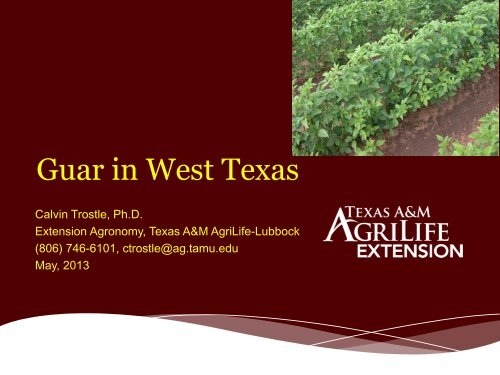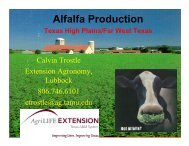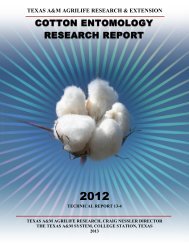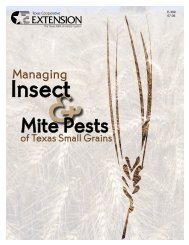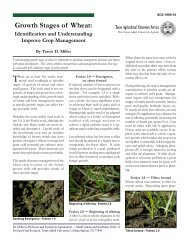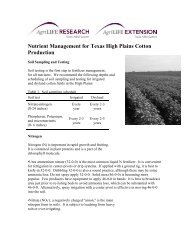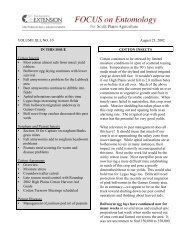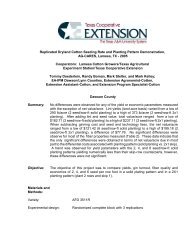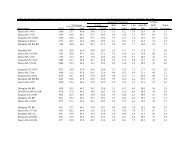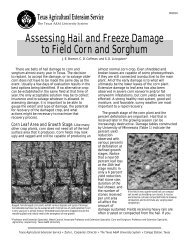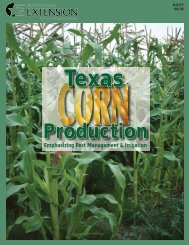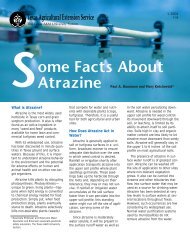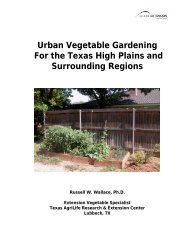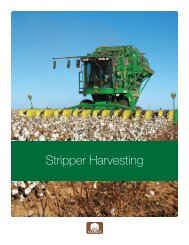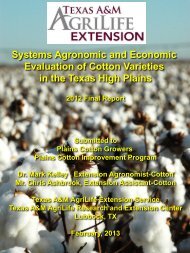Guar in West Texas - Texas A&M AgriLife Research & Extension ...
Guar in West Texas - Texas A&M AgriLife Research & Extension ...
Guar in West Texas - Texas A&M AgriLife Research & Extension ...
- No tags were found...
You also want an ePaper? Increase the reach of your titles
YUMPU automatically turns print PDFs into web optimized ePapers that Google loves.
<strong>Guar</strong> <strong>in</strong> <strong>West</strong> <strong>Texas</strong>Calv<strong>in</strong> Trostle, Ph.D.<strong>Extension</strong> Agronomy, <strong>Texas</strong> A&M <strong>AgriLife</strong>-Lubbock(806) 746-6101, ctrostle@ag.tamu.eduMay, 2013
Why <strong>Guar</strong>? Why Now? <strong>Guar</strong> gum is highly valuable and sought after as an<strong>in</strong>gredient from small quantities <strong>in</strong> numerous foodproducts to large scale uses <strong>in</strong> oil field services(e.g., a component of frac fluids)
Yes, <strong>Guar</strong>! Yes, Now! Uses range from a company need<strong>in</strong>g a few tons to maketens of thousands of tons of food <strong>in</strong>gredients or f<strong>in</strong>ished foodproducts, to an <strong>in</strong>dustry estimate of as much as 20,000 lbs.of guar gum to frac one oil well.◉ Can enough guar be produced for the oilfield <strong>in</strong>dustry? Onefrac job could require 80 acres of guar production (750 lbs./A)◉ FTS International, Ft. Worth, uses 1,700 tons of guar gum(2012) a month (3-4X current annual U.S. production)◉ Caremoli USA, 20,000,000 lbs. of guar gum as a food<strong>in</strong>gredient (~90,000 acres at 750 lbs./A)◉ Halliburton, mid-2012, guar gum was 30% of material cost tofrac a well (this dur<strong>in</strong>g a time of severely <strong>in</strong>flated prices forforeign guar gum)
<strong>Guar</strong> Markets Much of the guar consumed <strong>in</strong> the U.S. is importedfrom India and Pakistan as ‘splits’—theendosperm (which conta<strong>in</strong>s the valuable gum); theseed coat and embryo have been removed. As a rule of thumb for “Aggie Math” understand<strong>in</strong>g,the seed components are:◉ Embryo, 45%◉ Seed coat, 15%◉ Endosperm, conta<strong>in</strong><strong>in</strong>g the gum, 40% Figure about 28% of raw seed weight is netextractable gum
<strong>Guar</strong> Markets International market for guar and guar gum drivesyou nuts! There is no rhyme or reason to pric<strong>in</strong>gor availability. A manipulated market. Some companies suggest the gum quality ofimported guar is better than U.S. production Is this fact or perception?◉ <strong>Texas</strong> Tech Univ. research suggest quality can becomparable◉ <strong>Guar</strong> grades/quality for frack<strong>in</strong>g vs. guar for food
<strong>Guar</strong> Markets U.S. companies need a stable supply, and appearmore will<strong>in</strong>g to pay the needed cost. Due to volatility <strong>in</strong> the <strong>in</strong>ternational market (whichis controlled and does not necessarily reflectmarket conditions), <strong>in</strong>terest rises <strong>in</strong><strong>in</strong>vest<strong>in</strong>g/establish<strong>in</strong>g U.S. production when pricesare high What about food vs. <strong>in</strong>dustrial use debate?◉ Blue Bell ice cream—the run-up <strong>in</strong> guar pricesamounts to ~10-12 cents higher <strong>in</strong>gredient cost perhalf gallon carton which costs $5-6
<strong>Guar</strong> Economics <strong>Guar</strong> is a crop that hasm<strong>in</strong>imal <strong>in</strong>put costs to grow.Therefore the gross returns(which seem low), must beevaluated <strong>in</strong> light of actual(low) production costs. Historically, guar is not acrop of choice if you as aproducer must service a highdebt load. <strong>Guar</strong> production budgets @http://southpla<strong>in</strong>sprofit.tamu.edu
<strong>West</strong> <strong>Texas</strong> <strong>Guar</strong>, Brownfield, TX Operat<strong>in</strong>g s<strong>in</strong>ce 1998 Installed equipment to produce guar powder(gum) <strong>in</strong> 2009◉ Can’t produce enough to meet demand; also canprocess organic guar gum◉ Subsidiary is <strong>Guar</strong>-Tex, http://www.guar-tex.com Regularly contacted by companies want<strong>in</strong>gguar gum, but WTG’s goal is to establishstable long-term supply rather than contractlarge acreages for a limited time, to meetoilfield service needs.
<strong>West</strong> <strong>Texas</strong> <strong>Guar</strong>, Brownfield, TX Delivery to Brownfield and possibly other locationssuch as Knox City, TX <strong>in</strong> the Roll<strong>in</strong>g Pla<strong>in</strong>s◉ Currently the only U.S. bus<strong>in</strong>ess accept<strong>in</strong>g raw guar fromthe farm Contracted production <strong>in</strong> past five years is about10,000 to 30,000 acres (historical high near 50,000acres) 2012 price was the highest ever, $0.35/lb. for standardGrade #1 2013 price is $0.45/lb. for Grade #1 (806) 637-4662, http://www.westtexasguar.com
2012 Seed Price for Farmers 2012 price was the highest ever, $0.35/lb. for standardGrade #1 Phone calls and e-mails: “With the high cost of guargum, why isn’t guar production contract<strong>in</strong>g at least$0.50/lb., even $1.00/lb.? The recent crash <strong>in</strong> guar gum prices might be why!!!◉ As of mid-September 2012 guar gum prices were back down to about$3.50 per lb. “It will take $0.50/lb. to get farmers seriously<strong>in</strong>terested and off the fence” (especially withoutcrop <strong>in</strong>surance).” Jackie Smith, <strong>Extension</strong> Ag. Economics, Lubbock
“Poor Man’s Crop” (India) vs.“Low-Input/Stepchild Crop” (U.S.)
Key <strong>Guar</strong> Considerations Indeterm<strong>in</strong>ant, annual legume Good for rotations with cotton, sorghum, etc. (1970’s at<strong>Texas</strong> A&M <strong>AgriLife</strong>—Vernon: 15% l<strong>in</strong>t yield <strong>in</strong>crease thefollow<strong>in</strong>g year) As drought tolerant—if not more—than any other crop <strong>in</strong><strong>Texas</strong> (sesame would be similar) Low risk
<strong>Guar</strong> With sesame, the most drought tolerant crop on South Pla<strong>in</strong>s Low <strong>in</strong>put crop No <strong>in</strong>sects or disease treated <strong>in</strong> production s<strong>in</strong>ce ~1998 Target plant<strong>in</strong>g date: mid-May to about July 1 Harvest generally November-December <strong>in</strong> High and Roll<strong>in</strong>gPla<strong>in</strong>s (this is without harvest aid, which could hastenharvest a month or more) How quickly can new crop guar gum be available? Couldpotentially hit market <strong>in</strong> December if facilities can processquickly (earlier with harvest aid)
Yield Potential Dryland: 400-1,100 lbs./A (typical range)◉ Gett<strong>in</strong>g an <strong>in</strong>itial stand is important; once the standis established then guar is highly likely to make acrop even <strong>in</strong> drought years◉ Key long-time WTG growers—experience isvaluable!—averaged 800 to 1,000 lbs./A s<strong>in</strong>ce 1999 Limited irrigation (3-6”): 800-1,400 lbs./A Full irrigation? Not recommended◉ <strong>Guar</strong>’s relative performance to other crops is best <strong>in</strong> drylandsett<strong>in</strong>gs, especially when droughty as long as the crop isestablished, but guar may not take advantage of irrigation aswell as numerous other crops. WTG yield goals ~900 lbs./A dryland; ~1,500 lbs./Airrigated
Varieties 1980-1983, at numerous Vernon-area locations:◉ Lewis ~100 lbs./A more than K<strong>in</strong>man◉ Lewis ~200 lbs./A more than Esser K<strong>in</strong>man, Lewis (less branch<strong>in</strong>g, more pods on ma<strong>in</strong>stem), Matador (<strong>Texas</strong> Tech Univ., 2005), and SantaCruz are most common varieties--All are acceptable;see contractor Breed<strong>in</strong>g program can make rapid improvements,especially if newer techniques are coupled with readyassessment of gum quantity and quality
Dryland <strong>Guar</strong> YieldsAGCARES, 2001-2002 Dry years, but deep moisture available K<strong>in</strong>man and Lewis yields (averaged)--◉2001: 549 lbs./A◉2002: 829 lbs./A
Where is <strong>Guar</strong> Best Suited? Grows adequately under a wide range of soilconditions◉ Clayey soils are not recommended Performs best on medium- and sandy textured soils Dryland pivot corners Fields without heavy weed pressure Humid environments are not desirable◉◉Alternaria, bacterial blight, other diseases beg<strong>in</strong> to take their tollIndi and Paki varieties are exposed to humidity dur<strong>in</strong>g the monsoonseasons, may handle disease potential better?
Herbicide <strong>Texas</strong> A&M <strong>AgriLife</strong> has submitted <strong>in</strong>formation for 2,4-DBapproval <strong>in</strong> 2012 to the EPA IR-4 specialty crop program forpossible label<strong>in</strong>g as an post-emerge over-the-top broadleafweed control option.◉ Proposed label is for 1.0 p<strong>in</strong>t per acre applied up to 6” tall or 6weeks, whichever comes first.
Rhizobium Inoculation I have the same frustration as you: poor to nonodulation <strong>West</strong> <strong>Texas</strong> research (Dawson Co.):◉ <strong>Guar</strong> seedbox powder (an <strong>in</strong>ferior product), and now nolonger commercially available◉ Concentrated peanut liquid Lift as advised by company(Bradyrhizobium)◉ Noth<strong>in</strong>g! No <strong>in</strong>crease <strong>in</strong> nodulation.◉ Some ‘seed <strong>in</strong>oculants’ used <strong>in</strong> guar (e.g., Sono Ag.,Pla<strong>in</strong>view, TX) have Rhizobium, and other biologicals butmay not be specific to guar
RhizobiumNodules on <strong>Guar</strong>Rhizobium nodules on guar roots
Seed<strong>in</strong>g ~5 lbs./A dryland, ~8 lbs./A irrigated; higher seed<strong>in</strong>grates (~10 lbs./A) may <strong>in</strong>crease stem node length atthe soil l<strong>in</strong>e, like <strong>in</strong> soybean, and ease harvest◉ Old TX Roll<strong>in</strong>g Pla<strong>in</strong>s research suggested that 2 to 10lbs./A produced no difference <strong>in</strong> yield Listed ground, 4-8” tall beds, can help harvest 70°F for optimum establishment at plant<strong>in</strong>g◉ This is about as warm a soil as needed for any crop
Fertility Results AGCARES, Dawson Co., TX Be<strong>in</strong>g a legume (“guar is a soil builder”—NOT; it has to benodulated); Nitrogen should not be a consideration Two-year results on dryland guar: no measurable yieldresponse to 30 lbs./A P 2 O 5 India: most common micronutrient deficiency is Z<strong>in</strong>c
Insects and Disease None treated for yet <strong>in</strong> <strong>West</strong> <strong>Texas</strong> <strong>in</strong> 1998-2012◉ Alternaria, bacterial blight (‘Monument’ is susceptible) <strong>Guar</strong> midge (<strong>in</strong>fects bud)--not the same <strong>in</strong>sect as sorghummidge but is the alfalfa midge◉ Infrequent issue, but sprayed for <strong>in</strong> Hardeman Co. <strong>in</strong> 2012
Insects and Disease Of two <strong>Texas</strong> Tech variety releases <strong>in</strong> about 2005, onevariety, ‘Monument’ is very susceptible to disease—notrecommended◉ Initial test<strong>in</strong>g suggested disease was bacterial blight Alternaria is somewhat common on guar, but usually not atdamag<strong>in</strong>g levels, and not practical to treat
<strong>Guar</strong>--Profitability ‘Keys’ Production as a primary crop is better than as catch crop Wait to plant until soil moisture for germ<strong>in</strong>ation/emergence isgood
<strong>Guar</strong>--Profitability ‘Keys’ Irrigation response: ~100-150 lbs./A per 1”◉ Caveat: 2001, Dawson Co.◉ Dryland corners, 1,100 lbs./A (a good year!)◉ Over-the-top spr<strong>in</strong>kler irrigation same as neighbor<strong>in</strong>gpeanuts, 700 lbs./A (frequent spray irrigation) <strong>in</strong>terferedwith flower<strong>in</strong>g, poll<strong>in</strong>ation, seed set, or all three◉ Consider drag hoses for irrigation other than <strong>in</strong>itialwater<strong>in</strong>g to get crop up
<strong>Guar</strong>--Profitability ‘Keys’ Experienced harvesters with right headers and can <strong>in</strong>creaseharvestable yield considerably◉ Especially with air-reels, which I th<strong>in</strong>k are worth the added cost($2-4/acre) with the custom harvester◉ S<strong>in</strong>ce guar has a tendency for the pods to break off at harvest(break off, not split open), the air reel blows these shatteredpods <strong>in</strong>to the header
Air-Reel Headers
Need for Harvest Aid Use <strong>in</strong> <strong>Guar</strong> If guar rema<strong>in</strong>s <strong>in</strong> the field a long time wait<strong>in</strong>g for a kill<strong>in</strong>gfrost, plant death, and subsequent dry-down, some seedmay turn black, especially if wet conditions prevail andharvest is delayed.◉ This reduces grade and potentially reduces gum quality Use of a labeled harvest aid (desiccant, defoliant, herbicide)can allow earlier harvest and potentially higher quality guargum product◉ Paraquat (Gramoxone)◉ Glyphosate (Roundup, others)◉ Sodium chlorate
Seed Quality Germ<strong>in</strong>ation %? Ma<strong>in</strong>ta<strong>in</strong> as high as you can get, but someguar may have germ of only ~67% after a couple of years◉ Long-term seed storage usually sees guar seed qualitydeteriorate to unacceptable levels after ~8 years <strong>Guar</strong> seed must be free of morn<strong>in</strong>gglory! Similar size &shape seed that can’t be cleaned out
Seed Quality—Black Seed <strong>Texas</strong> Tech Univ. research on black seed, which is oftenassumed to be of <strong>in</strong>ferior quality, and appears to be morecommon <strong>in</strong> the Roll<strong>in</strong>g Pla<strong>in</strong>s than <strong>in</strong> the High Pla<strong>in</strong>s Germ<strong>in</strong>ation is higher <strong>in</strong> black seed (degradation of seedcoat, better water uptake), but endosperm content was notsignificantly different—gum content and quality notreported among differentcolored seeds.Journal of Arid Environments 70 (2007) 29–38.
Raw <strong>Guar</strong> Grad<strong>in</strong>g Standards†These are the standard grades for U.S. grown guar off thefarm. Contract price is based on #1 Grade, and will specifydiscounts for lower grade.GRADE MOISTURE MAXIMUMMINIMUM TEST WEIGHT(Lbs./Bushel)Number 1 13.5 60Number 2 14.0 59Number 3 14.5 58Number 4 15.0 57SAMPLE GRADE above 15.1 below 56.9†Grades courtesy <strong>West</strong> <strong>Texas</strong> <strong>Guar</strong>.<strong>Guar</strong> price may discount for black/dark seed above a certa<strong>in</strong> % as darkseed may <strong>in</strong>dicate possible lower gum quality. Dark seed often occursdue to greatly delayed harvest, ra<strong>in</strong>y weather after maturity, or both.
<strong>Guar</strong>--Mistakes Plant<strong>in</strong>g when soil moisture conditions are poor--poor standestablishment <strong>Guar</strong> is not for weedy ground--only two herbicides currentlylabeled Need to consider harvest method prior to plant<strong>in</strong>g--headertype will affect flat vs. bedded plant<strong>in</strong>g; custom comb<strong>in</strong>e,$25/A Not us<strong>in</strong>g limited irrigation if it is available ATTITUDE!!!
What Growers Say S<strong>in</strong>ce 2001 Use higher seed<strong>in</strong>g rates, maybe 8 lbs./A even on dryland Water up vs. plant<strong>in</strong>g <strong>in</strong>to moisture (preferred?); watch forcrust Reduced performance on ground which has undergone‘deep break<strong>in</strong>g’ tillage (12-16”) “I like the condition of my ground after guar” “My cotton looks better after guar” Roundup Ready “flex” cotton aids control of volunteer guarthe next year (can be sprayed season long if needed)
What Growers Say S<strong>in</strong>ce 2001 “Butch job” harvest<strong>in</strong>g—avoid it Pay for experienced harvesters with right equipment How are you go<strong>in</strong>g to harvest?--ask at plant<strong>in</strong>g time “Got to get <strong>in</strong>to the dirt” with your header to get all the yield Chemical term<strong>in</strong>ation or bean knif<strong>in</strong>g?
Where Must <strong>Guar</strong> Yields Go?And What Type of Production? <strong>Guar</strong> at 50,000 acres <strong>in</strong> the U.S. vs. 250,000 acres or even500,000 acres annually? Large guar gum users need major consistent supply tosubstantially commit to U.S. guar (quality considerationsperhaps a different matter) 200 million pounds of guar gum use <strong>in</strong> North America?That’s about 700,000 acres of production at 1,000 lbs./A. We can’t reliably achieve this with only dryland—to makethis potential viable and reliable, we have to:◉ <strong>in</strong>crease yield per acre (breed<strong>in</strong>g, GMO?, management)◉ produce some guar on irrigated land to m<strong>in</strong>imize drought
Future Seed <strong>Guar</strong> Seed Supplies <strong>West</strong> <strong>Texas</strong> <strong>Guar</strong> only supplies seed to those who havesigned production contracts <strong>Texas</strong> Foundation Seed Service, a unit of <strong>Texas</strong> A&M<strong>AgriLife</strong> <strong>Research</strong>, has some foundation ‘K<strong>in</strong>man’◉ Currently $4/lb. for high purity foundation seed (otherwisecertified seed would be ~$2/lb.)◉ TFSS is <strong>in</strong>creas<strong>in</strong>g small quantities of public varieties ‘Lewis’and ‘Santa Cruz’ <strong>in</strong> 2013◉ http://tfss.tamu.edu (Steve Brown) Hardeman Gra<strong>in</strong>, Chillicothe, TX, 940-852-5118, has someK<strong>in</strong>man available <strong>in</strong> 2013
Future Seed <strong>Guar</strong> Seed Supplies Status and availability of Plant Variety Protected (PVPA)varieties Matador and Monument released by <strong>Texas</strong> TechUniv. is unknown (would require a Material TransferAgreement, royalty payments from at seed purchase or fromproduction) To <strong>in</strong>quire on their status, contact Dr. Dick Auld, Plant & SoilSciences breeder, 806-742-5704, dick.auld@ttu.edu


